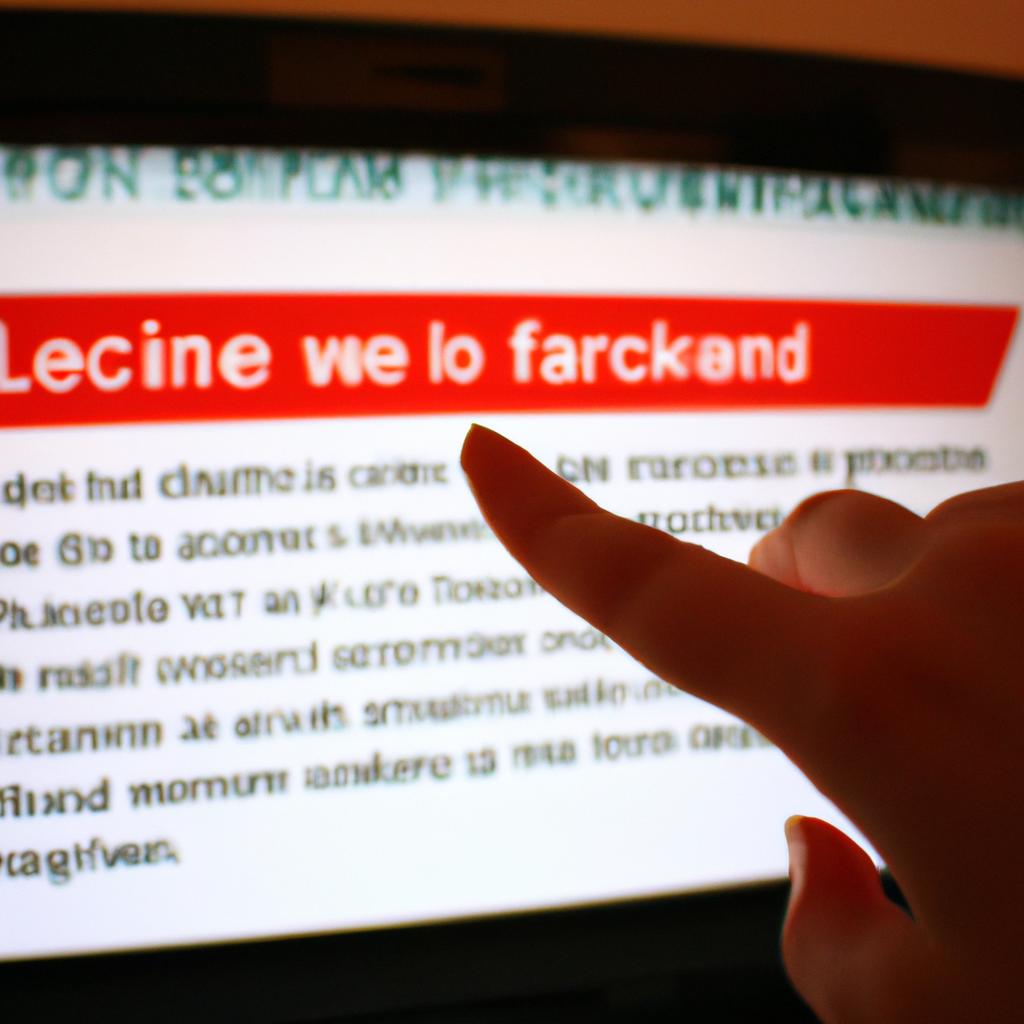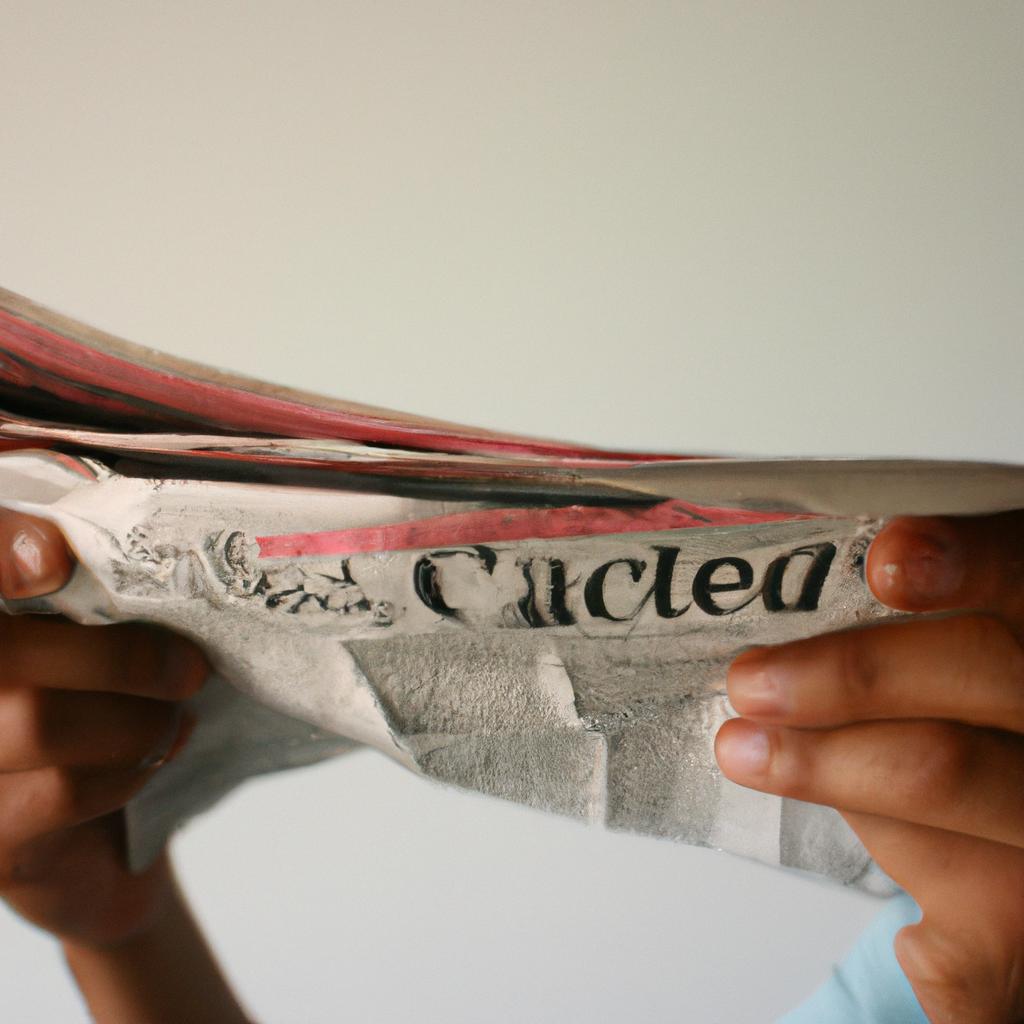Fake news has become a prevalent issue in the contemporary news media industry, leading to widespread misinformation and public confusion. This article aims to shed light on the practice of fact-checking within this industry, highlighting its importance in debunking false information and restoring trust among audiences. To illustrate the significance of fact-checking, consider a hypothetical scenario where a popular news outlet publishes an article claiming that a newly developed drug can cure cancer without providing any substantial evidence or scientific backing. Such misleading claims not only jeopardize public health but also undermine the credibility of the entire news media industry.
In recent years, fake news has gained traction due to various factors such as social media’s rapid dissemination capabilities and people’s increasing reliance on online sources for information. Consequently, it has become crucial for news organizations to adopt rigorous fact-checking practices to counteract the spread of misinformation effectively. Fact-checking involves meticulously verifying claims made by journalists or other sources against reliable evidence before publishing them. By subjecting information to rigorous scrutiny, fact-checkers play a vital role in separating truth from falsehoods, ensuring that accurate and verified information reaches the audience. Moreover, thorough fact-checking allows for accountability within the news media industry by holding journalists accountable for their reporting and preventing the propagation of baseless claims.
The importance of fact-checking cannot be overstated, especially in situations where public health and safety are at stake. In the hypothetical scenario mentioned earlier, a news outlet publishing an unsubstantiated claim about a cancer-curing drug could potentially lead desperate individuals to pursue ineffective or even harmful treatments. Through rigorous fact-checking, such misinformation can be debunked, protecting the public from potential harm.
Moreover, fact-checking plays a crucial role in restoring trust among audiences. With the prevalence of fake news, many people have become skeptical of information presented by news organizations. By consistently providing accurate and verified information through thorough fact-checking processes, news outlets can demonstrate their commitment to journalistic integrity and regain the trust of their audience.
To ensure effective fact-checking practices, news organizations should invest in specialized teams or partnerships with reputable fact-checking organizations. These teams can employ various methods such as verifying sources, consulting experts in relevant fields, analyzing data and statistics, and cross-referencing information with credible sources before publishing any claims. Additionally, transparency is key – news outlets should clearly communicate their fact-checking process to their audience and provide access to the evidence supporting their conclusions.
In conclusion, fact-checking plays a vital role in combating fake news and maintaining the credibility of the news media industry. It safeguards public health and safety by debunking false claims that could potentially harm individuals. Moreover, it helps restore trust among audiences by providing accurate and verified information. By investing in robust fact-checking practices and promoting transparency, news organizations can effectively counteract misinformation and uphold journalistic integrity.
The Importance of Fact-Checking in Journalism
In today’s fast-paced digital era, the spread of misinformation and fake news has become a significant challenge for the news media industry. False information can easily go viral, leading to widespread confusion and mistrust among readers. To address this issue, fact-checking plays a crucial role in ensuring accurate reporting and maintaining journalistic integrity.
To illustrate the impact of unchecked information, consider a hypothetical scenario where a major news outlet publishes an article claiming that a particular vaccine causes severe side effects. Without proper fact-checking procedures in place, this false claim could quickly gain traction on social media platforms, causing panic and potentially dissuading individuals from getting vaccinated. In such instances, it becomes essential for journalists to verify their sources diligently before disseminating any information.
Fact-checking serves several important purposes within journalism:
- Preventing the spread of misinformation: By rigorously verifying claims made by sources or public figures, journalists can halt the dissemination of false or misleading statements.
- Maintaining credibility: Engaging in thorough fact-checking practices helps news organizations establish trust with their audience by consistently delivering accurate and reliable information.
- Enhancing transparency: Making the process of fact-checking visible to readers allows them to understand how journalists arrive at their conclusions and fosters greater accountability within the industry.
- Promoting informed decision-making: Accurate reporting enables citizens to make well-informed decisions based on reliable information rather than fallacies or unverified claims.
Here is an example table depicting the potential consequences arising from inadequate fact-checking efforts:
| Consequence | Description | Impact |
|---|---|---|
| Misinformation Spread | When inaccurate or misleading content goes unverified, it risks being shared widely through various channels, resulting in a lack of trust towards credible sources | Erosion of public confidence |
| Damage to Reputation | News outlets that consistently fail to fact-check their content may experience a decline in credibility, leading to a loss of readership and influence | Diminished authority |
| Legal Consequences | Publishing false information can have legal consequences for news organizations, including defamation lawsuits or regulatory penalties | Financial burden and reputational damage |
| Polarization | The absence of accurate reporting fuels the creation of echo chambers and contributes to political polarization, as individuals rely on biased sources that confirm their pre-existing beliefs rather than seeking out diverse perspectives | Fragmented society and diminished public discourse |
In conclusion, fact-checking serves as an essential tool within the journalism industry. By ensuring accuracy and reliability in reporting, journalists can combat misinformation, build trust with their audience, promote transparency, and empower citizens to make informed decisions. In the following section, we will explore various methods used by journalists to verify information in news articles.
Methods Used to Verify Information in News
Transitioning from the importance of fact-checking in journalism, it is crucial to explore the methods employed by news organizations to verify information before publishing. To illustrate this, let us consider a hypothetical case study where a news outlet receives an anonymous tip claiming that a local politician has been involved in corrupt activities. The journalists who receive this tip must follow specific procedures to ensure the accuracy and reliability of their reporting.
Firstly, when investigating such claims, journalists often conduct extensive research to gather as much relevant information as possible. They analyze public records, interview sources with direct knowledge or expertise on the matter, and examine any available documentation supporting or refuting the allegations. This process helps them establish a comprehensive understanding of the situation they are investigating.
Secondly, cross-referencing sources plays a vital role in fact-checking. Journalists consult multiple independent sources to corroborate or disprove the information provided by their initial source(s). By seeking different perspectives and verifying details across various reputable sources, reporters can ascertain whether the claim holds true or if it lacks substantiation.
Thirdly, fact-checkers employ specialized tools and technologies designed to detect misinformation and manipulation techniques commonly used online. These tools enable journalists to assess the credibility of online content through various means like reverse image searches, examining metadata, tracing backlinks, and analyzing patterns associated with known fake news outlets or propaganda campaigns.
To emphasize the significance of these verification methods for ensuring accurate reporting, here is a bullet point list highlighting some potential consequences if proper fact-checking measures are not implemented:
- Dissemination of false information leading to public confusion
- Undermined trust in media organizations
- Damage inflicted upon individuals’ reputations based on unverified accusations
- Wider societal implications resulting from decisions made using inaccurate data
Moreover, newsrooms often utilize structured processes while verifying facts within tight deadlines. Here’s an example table outlining three key steps followed during the fact-checking process:
| Fact-Checking Steps | Description |
|---|---|
| Step 1: Information Assessment | Evaluate the credibility and reliability of sources, scrutinize available evidence, and identify any potential biases. |
| Step 2: Verification Techniques | Utilize investigative techniques like cross-referencing multiple sources, consulting experts in relevant fields, and employing specialized tools to ensure accuracy. |
| Step 3: Editorial Review | Submit findings to internal editorial boards for further scrutiny, ensuring that all claims are supported by verified evidence before publication. |
In conclusion, news organizations employ various methods to verify information before publishing it as accurate news. These include conducting extensive research, cross-referencing sources, utilizing specialized tools and technologies, and following structured fact-checking processes. By implementing these measures diligently, journalists strive to deliver reliable information to the public.
Moving forward into the next section on “Common Misconceptions about Fact-Checking,” we will address some prevalent misunderstandings surrounding this critical journalistic practice without compromising its integrity or effectiveness.
Common Misconceptions about Fact-Checking
In the fast-paced digital age, where information spreads rapidly and unchecked, fact-checking plays a crucial role in ensuring the credibility of news content. This section explores the various methods employed by journalists and fact-checkers to verify information before it is disseminated to the public.
To illustrate the importance of these methods, let’s consider a hypothetical scenario: A popular news article claims that a new study has found a link between excessive smartphone use and an increased risk of mental health disorders among teenagers. Before accepting this claim as truth, responsible journalists would employ several verification techniques:
-
Source Evaluation:
- Determine if the source itself is reputable.
- Assess whether multiple sources corroborate the findings.
- Consider any potential biases or conflicts of interest.
-
Cross-Referencing:
- Compare the information with existing studies on related topics.
- Consult experts in the field for their opinions and insights.
- Analyze how well the information aligns with established scientific knowledge.
-
Fact-Checking Organizations:
- Rely on independent fact-checking organizations’ assessments.
- Check if such organizations have investigated similar claims in the past.
- Evaluate their reputation and methodology for accuracy.
-
Digital Forensics:
- Utilize advanced tools to analyze metadata, timestamps, and geolocation data.
- Examine social media trends and patterns surrounding the topic.
- Identify any manipulations or alterations made to images or videos.
These methods collectively contribute to improving accuracy within journalism by minimizing errors and reducing misinformation propagation. By incorporating robust fact-checking practices into their workflows, news organizations can enhance transparency, build trust with their audience, and combat fake news effectively.
Moving forward from understanding these verification techniques, we will delve into common misconceptions about fact-checking and address their implications for maintaining credibility in our subsequent section: “Common Misconceptions about Fact-Checking.”
The Role of Fact-Checking in Maintaining Credibility
The Role of Fact-Checking in Maintaining Credibility
To understand the significance of fact-checking in maintaining credibility, let us consider a hypothetical example. Imagine a news article circulating on social media claiming that a new study proves chocolate consumption leads to weight loss. Without proper fact-checking mechanisms, this misleading information could easily spread and misinform individuals seeking health advice.
One way the news media industry combats such misinformation is through rigorous fact-checking processes. These processes involve verifying claims made within articles or news segments to ensure accuracy and truthfulness. By engaging in thorough fact-checking, news organizations can maintain their reputation for delivering reliable and credible information to the public.
When it comes to fact-checking, there are several key aspects that journalists and editors focus on:
- Source evaluation: Assessing the reliability and expertise of sources used in an article.
- Cross-referencing: Checking multiple reputable sources to validate facts before publishing.
- Verification of data: Ensuring statistics and data presented are accurate and supported by evidence.
- Contextual analysis: Examining whether claims align with broader knowledge and understanding.
These practices help prevent the propagation of false or misleading information that can harm public discourse and decision-making. To illustrate how these practices contribute to maintaining credibility, consider the following table:
| Misinformation | Fact-checked Information |
|---|---|
| Chocolate causes weight loss | Scientific studies have not found conclusive evidence supporting this claim. In fact, excessive chocolate consumption can lead to weight gain due to its high sugar content. |
| Vaccines cause autism | Extensive scientific research has consistently shown no causal relationship between vaccines administered according to recommended schedules and autism spectrum disorders. |
| Climate change is a hoax | There is overwhelming consensus among climate scientists that human activities contribute significantly to global warming, leading to various environmental impacts worldwide. |
| COVID-19 originated from 5G technology | Numerous scientific studies and investigations by health organizations have debunked this claim, affirming that the SARS-CoV-2 virus responsible for COVID-19 is of natural origin. |
By engaging in robust fact-checking practices, news media outlets can ensure they disseminate accurate information, contributing to a well-informed society.
Transitioning into the subsequent section about “Challenges Faced in Debunking Misinformation,” it becomes evident that while fact-checking plays a crucial role in maintaining credibility, there are several hurdles to overcome in effectively countering misinformation. These challenges arise due to the complexities surrounding the dissemination and reception of misleading information. Understanding these obstacles is vital for developing strategies to combat fake news effectively.
Challenges Faced in Debunking Misinformation
Debunking misinformation is a critical task for fact-checkers in the news media industry. However, it comes with several challenges that can hinder their efforts to maintain credibility and promote accurate reporting. One such challenge is the rapid spread of false information on social media platforms, which requires fact-checkers to work swiftly and efficiently to counteract its impact.
For instance, let us consider a hypothetical scenario where a misleading video claiming a new miracle cure for a widespread disease surfaces online. This video quickly goes viral, garnering millions of views before any fact-checker has had the chance to assess its validity. In this situation, fact-checkers face the daunting task of debunking the misinformation while being aware that it has already reached a wide audience who may have been influenced by its content.
To better understand the challenges faced by fact-checkers in debunking misinformation, we can examine some key factors:
- Information overload: The sheer volume of information available online makes it difficult for fact-checkers to identify and address every piece of false information effectively.
- Confirmation bias: People tend to believe information that aligns with their pre-existing beliefs or opinions, making it challenging to change their minds even when presented with factual evidence.
- Technical manipulation: Advancements in technology have made it easier than ever to create convincing fake images, videos, and audio recordings that are difficult to distinguish from reality.
- Limited resources: Fact-checking organizations often operate under tight budgets and limited staff capacity, which restricts their ability to thoroughly investigate all claims and reach wider audiences.
Table: Emotional Response Elicited by Challenges Faced in Debunking Misinformation
| Challenge | Emotional Response |
|---|---|
| Information overload | Overwhelmed |
| Confirmation bias | Frustration |
| Technical manipulation | Bewilderment |
| Limited resources | Concern |
These challenges underscore the complex nature of debunking misinformation in today’s fast-paced digital landscape. Fact-checkers must navigate through a multitude of obstacles while striving to maintain accuracy and credibility. Overcoming these hurdles requires collaboration between news organizations, social media platforms, and fact-checking agencies to develop effective strategies that can combat false information effectively.
As we consider the challenges faced by fact-checkers in their mission to uphold truthfulness and accountability, it becomes evident that addressing these issues is crucial for the future of fact-checking in the news media industry.
The Future of Fact-Checking in the News Media
Debunking misinformation in the news media industry is a challenging task that requires careful fact-checking and critical analysis. As we have explored in the previous section, there are several obstacles faced when attempting to counter false information. However, despite these challenges, it is crucial to consider the future of fact-checking in order to maintain trust and integrity within the news media landscape.
One example that highlights the significance of debunking fake news involves a widely circulated article claiming that a new miracle drug could cure cancer. This story gained significant traction on social media platforms, with many individuals sharing it without verifying its authenticity. However, through diligent fact-checking by reputable news organizations, it was revealed that this supposed breakthrough was nothing more than an elaborate hoax designed to take advantage of vulnerable patients seeking hope. By exposing such fraudulent claims, journalists play a vital role in protecting public health and ensuring accurate information reaches society.
Despite the challenges faced in combating misinformation, there are strategies that can be implemented to enhance fact-checking efforts:
- Collaboration: Promoting collaboration between different news organizations and fact-checkers can lead to more comprehensive investigations and increased credibility.
- Education: Educating individuals about how to spot fake news and encouraging critical thinking skills can empower readers to discern reliable sources from unreliable ones.
- Technology: Utilizing innovative technologies like artificial intelligence (AI) tools or automated fact-checking algorithms can help streamline the process of identifying false information.
- Transparent Corrections: News outlets should prioritize issuing corrections promptly and transparently when inaccuracies or errors are identified.
To further understand the future implications of fact-checking within the news media industry, let us examine some potential scenarios:
| Scenario | Impact | Importance |
|---|---|---|
| Increased Automation | Streamlines fact-checking processes | Enhances efficiency |
| AI-generated Fake Content | Challenges traditional verification methods | Requires adaptation |
| Global Collaboration | Strengthens fact-checking efforts | Enhances credibility |
| Government Regulations | Balances freedom of speech and accuracy | Sparks ethical discussions |
In conclusion, the future of fact-checking in the news media industry is critical for maintaining public trust and combating the spread of misinformation. By addressing challenges through collaboration, education, and technological advancements, journalists can continue to play a crucial role in debunking fake news. Moreover, staying vigilant about potential scenarios that may impact fact-checking will allow us to adapt and develop effective strategies to ensure accurate information reaches the public.
Overall, it is evident that while debunking misinformation poses significant obstacles, proactive measures can be taken to mitigate its effects on society.




